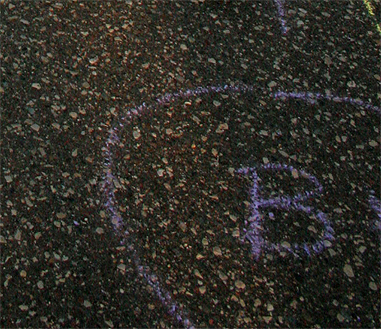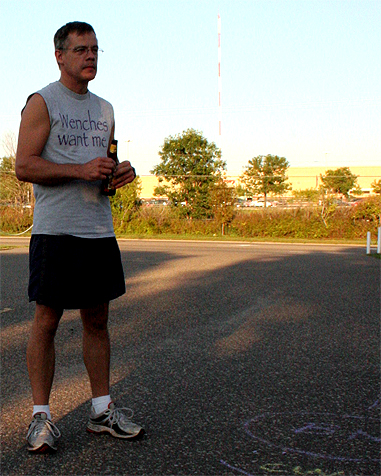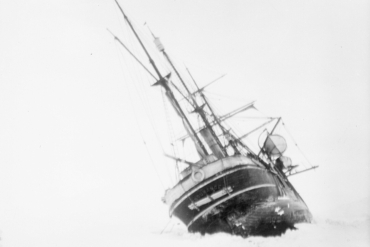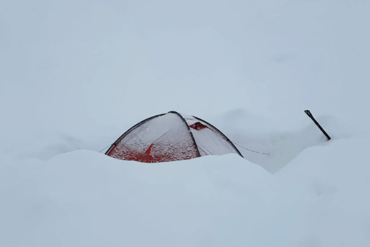Hash House Harriers
The Drinking Club with a Running Problem
By STEPHEN REGENOLD
published July 10, 2008
It was Friday night at the Blue Fox Bar & Grill, a sprawling sports pub in Arden Hills, Minn., when I met the tall man wearing bunny ears.
“I am Bob-Shiggy-Bob,” he said, jabbing a hand forward to greet. We were in the parking lot, with cars pulling in during dinner rush, and Bob was clenching an amber brew. He wore a blue T-shirt and running shoes; a fluffy pink tail poked out from his shorts.
Bob’s smile was half-cocked, a smirk leaning left like he was up to no good. “The cooler’s in there,” he said, pointing to a space between two parked cars.

Hash Club leader Bob-Shiggy-Bob dressed to run.
I’d come to run with the Hash House Harriers, a come-as-you-are running club that meets multiple times a month to jog and chase in an elaborate game that might include pounding out a half-dozen miles, and maybe chugging as many beers along the way.
“We’re a drinking club with a running problem,” said Bob-Shiggy-Bob, aka Bob Schriver, a 56-year-old veteran hasher who had donned the bunny suit to serve as “hare.”
The tradition of hashing started nearly 70 years ago in Kuala Lumpur, Malaysia, when a group of British expatriates formed a club to exercise and imbibe after work once a week. Initially, one runner—the hare—would take off with a head start, dropping bits of paper as a trail of clues for the pack—the harriers—to follow. The goal was twofold: to catch the hare, and to reach the adult refreshments at the end of the line.
Hashing grew throughout the 20th century as an underground and word-of-mouth phenomenon. Today, hashing clubs exist in many major cities worldwide, from New York to L.A. to Tokyo. There is no rulebook but for tradition, and hashing has no governing body.

The end goal to every Hash run: a cooler of beverages and beer.
Chalk markings on pavement have replaced paper as a means for the hare to tag a trail. Esoteric symbols—checks, dashes, vectors, splotches and arrows—create the ad hoc courses that harriers sprint along and decipher on the go.
Alcohol plays an ancillary role, some hashers imbibing before, during and after the run, while others stick to water. “Not everyone’s accustomed to exercise and beer,” Schriver said.
During my run—which included 12 harriers on a pre-marked course—most everyone had a beer in their belly when Schriver shouted to start. We jumped off in search of the first chalked clue, an arrow-and-vector graphic scrawled on pavement across the street near a Target store.
Our course for the night was a “dead” trail, meaning the hare (Schriver) was not actually running out ahead; he’d chalked the course beforehand, a common method. Our challenge was simply to find the route through a maze of suburban streets toward a cooler of beer at the end.
I ran initially with Wendy Bloom (48; hasher nickname: “Twiggy”) and Janet Aspen (35; “SnoHo”), respectively an event planner and a real-estate appraiser, both longtime hashers. “Exercise, friends and beer, in that order,” said Aspen. “That’s why I do it.”
We jogged south, jumping a curb, trotting across some grass, then swinging east on a side street. The pack dispersed immediately, runners heading to all points of the compass in search of clues.
“On-on!” a front-runner yelled back, signaling the crew in hasher-speak that he’d found the correct route.

Chalked clues provide the only guide through a tangle of streets.
The art of setting a trail—whether live while being chased or ahead of time for a dead trail—is partly defined by the setter’s ability to keep the harriers running together. During the chase, marked trail intersections require lead runners, who may be several minutes ahead of the group, to split up and search for the right route, sprinting a few hundred feet in four directions while looking for chalked clues. By the time the route is deciphered, many slower members have caught up.
Our run followed pavement for a half-mile before dipping into the woods. “Watch your eyes with these branches,” a harrier yelled back.
We were heading south along a lake, feet pounding a sandy trail on a shortcut to a county road. I jumped a railroad track at the end of the woods, rocks clinking underfoot, then set sights on the lead runner, a man I knew only as “Chipmunk.”
I went into a dead sprint, legs chugging like pistons for a few hundred yards, to catch my rodent friend. “On-on!” Chipmunk shouted as I joined his pace.
Bernie Vassar, Chipmunk’s alter ego, owns an automotive repair business. Seven years ago a car pulled into his shop with vanity license-plate frames identifying its driver as a hash-house harrier. “Since then, I’ve done 400 hashes,” said Vassar, who is 47.
It shows. Vassar kept a fast pace, knocking off 8-minute miles or better as we weaved through neighborhoods, looking for chalk. Circular splotches, blopped on by Schriver earlier in the evening with a flour-coated tennis ball, served as breadcrumbs every few feet.

Bernie Vassar, aka “Chipmunk,” prepping for the race.
The sun was fading when Vassar and I hit a dead end, forcing a U-turn. Six stragglers met us at an X drawn on cement. “Anything ahead?” one huffed, crouching, hands on his knees.
“We saw a BN,” Vassar said, referring to hasher code for “beer near” that signifies a pre-stashed stock of cans on ice.
But that BN never materialized. The sun soon set, a rust-golden sky fading to black. Then Vassar and I were alone in the dark, running, no trail in sight.
Cicadas buzzed in drooping branches. Streetlamps flickered to life. We ran west through deep twisting suburbia, jogging deserted lanes and cul-de-sacs, lost.
It’d been an hour by then on the hash, five or more miles of starting and stopping, sprinting ahead, then searching again for trail. Vassar gave up. “Time to head back,” he said. “Let’s find that cooler.”
We put our heads down and ran, arms swinging, lungs working, moving together silently. I was indeed beginning to feel the thirst.
(Stephen Regenold writes The Gear Junkie column for eleven U.S. newspapers; see www.THEGEARJUNKIE.com for video gear reviews, a daily blog, and an archive of Regenold’s work.)






